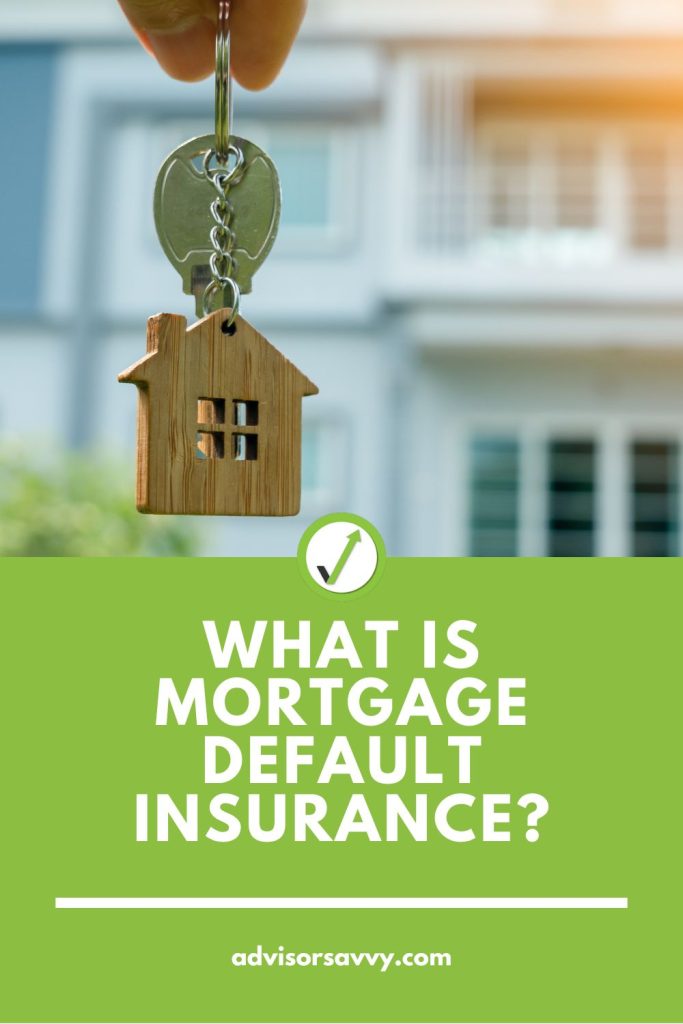
There are many barriers to home ownership in Canada. Mortgage default insurance aims to make homeownership more accessible with smaller down payments. It also ensures lenders are protected from mortgage defaults. This insurance carries high costs but has multiple payment options. It helps Canadians enter the homeownership market which is quite competitive and potentially facing a housing crisis. There are things you should understand before buying a home. Mortgage default insurance is one of them. Keep reading to learn more!

Table of contents
What is mortgage default insurance?
Mortgage default insurance is a type of insurance policy that protects a lender. If a borrower defaults on their mortgage loan, this insurance helps recover costs. This insurance is also known as mortgage insurance or mortgage guarantee insurance. In Canada, mortgage default insurance is required by law in most instances. Specifically, when a borrower makes a down payment that is less than 20% of the home’s purchase price.
Mortgage default insurance is paid for by the borrower but protects the lender. The insurance helps ensure the lender will not lose any of the money lent should the borrower default. If a borrower can no longer make payments on a mortgage, a property can go into foreclosure. In foreclosure, the lender will seize the property and attempt to resell it to cover the mortgage balance. This is high risk to any lender, particularly in a real estate market that is experiencing a downturn. The lender may have to sell the property for less than the mortgage value. Mortgage default insurance pays the difference in loan value versus foreclosure sale amount. Thereby ensuring lenders earn all their money back.
Related Reading: How Does A Mortgage Work In Canada?
Who administers mortgage default insurance in Canada?
The primary provider of mortgage default insurance in Canada is the Canada Mortgage and Housing Corporation (CMHC). The CMHC is a federal government agency. As a federal crown corporation, the CMHC creates much of the policy and standards around mortgage default insurance in Canada. They play a significant role in the Canadian housing market. Helping to gain access to homeownership, especially for those with smaller down payments.
Canada has two notable private mortgage default insurance providers. The private insurers are Sagen (formerly known as Genworth Canada) and Canada Guaranty. These private insurers operate similarly to CMHC and can be an alternative to the public source.
Borrowers typically have the option to choose between these three insurers. While the choice is up to the borrower, there are considerations. For this reason, mortgage brokers will facilitate which mortgage default insurer is used. This is because different mortgage default insurance providers have different relationships with lenders. It can be easier to secure a mortgage through the combination of a lender and insurance provider. However, it is important to always consider your options. Review the terms and conditions of the insurance provider and raise any concerns.
Your credit score & report. Always free, forever
It takes 3 minutes to join 20+ million people who trust ClearScore to help them improve their financial future
Related Reading: Pre-Approval for a Mortgage in Canada: What to Know
What does mortgage default insurance cover?
Mortgage default insurance primarily covers the lender. The insurance helps in situations where the borrower defaults on their mortgage payments. The coverage typically includes:
- Default by the Borrower. If the borrower is unable to make their mortgage payments and goes into default, insurance provides financial protection to the lender. This can include coverage for missed payments, foreclosure costs, and any potential losses incurred by the lender. In a way, it protects the borrower too so that they don’t have to worry about repaying a substantial loan should they run into financial trouble. But ultimately, the lender is the main party who benefits.
- Foreclosure Costs. If a lender needs to take ownership of a property and sell it, this is foreclosure. There are many fees associated with this action — it is not free. Mortgage default insurance may cover the costs of the legal process, property appraisals, and the sale of the property. This reduces the financial impact on the lender.
- Deficiency Balances. If a lender needs to sell a property for less than the mortgage value, insurance covers the difference. Ultimately lenders need to ensure they cover any balance loaned in a mortgage. In all real estate markets, this is not always possible. Mortgage default insurance may cover the deficiency. This is the difference between the outstanding loan amount and the proceeds from the sale.
Mortgage default insurance is designed to protect the lender, not the borrower. Borrowers can secure mortgages with a lower down payment using this insurance. However, it does not provide any direct benefits to the homeowner. The borrower is still responsible for making their mortgage payments. Failure to make payments makes mortgage default insurance the safety net for lenders.
Related Reading: What is Home Insurance?
Is mortgage default insurance mandatory in Canada?
In Canada, mortgage default insurance is mandatory for the majority of homebuyers. Particularly homebuyers who make a down payment of less than 20%. Mortgages with smaller down payments expose lenders to more risk. These risks include higher monthly payments and less equity to recuperate costs. In addition, lower down payments can indicate less financially stability in borrowers. With a down payment of less than 20%, a mortgage is considered a high-ratio mortgage. Canadian federal regulations require the purchase of mortgage default insurance, in this situation.
Related Reading: Residential Property Flipping Rule: What to Know
How much is mortgage default insurance?
The cost of mortgage default insurance is paid by the borrower. It can be a one-time premium or rolled into the total mortgage amount and paid overtime. Spreading the payment overtime may require additional interest to be paid. The exact cost is based on factors such as the down payment amount, the loan amount, and the amortization period. It is typically calculated as a percentage of the mortgage loan amount. The premium rates may vary between insurers. Although, CMHC’s insurance rates are as follows:
- For down payments of 5% to 9.99% > 4%.
- For down payments of 10% to 14.99% > 3.1%.
- For down payments of 15% to 19.99% > 2.8%.
Use CMHC’s mortgage calculator to calculate any potential mortgage insurance premium. These rates can change over time or based on individual circumstances. Further, there are variations among different mortgage insurers in Canada. Additionally, these rates may be subject to provincial sales tax. This would affect the overall cost of a purchase. Borrowers should always consult with their mortgage lender. This will allow the most accurate information on mortgage default insurance premiums.
How long do you pay CMHC?
CMHC mortgage default insurance premium is typically a one-time payment. Borrowers have the option to pay the premium upfront at the time of closing. For additional ease to homeownership entry, borrowers can add the insurance premium to the mortgage amount. It is then paid over the life of the loan. This means they will be paying interest on the premium amount over the term of the mortgage. Specific details of mortgages and insurance premiums paid can vary. Borrowers should read the fine print of their specific agreements.
Mortgage default insurance can be a one-time payment. However, the coverage only remains in effect until the borrower reaches 80% of the equity in the home. This is known as the loan-to-value ratio. At the 80% loan-to-value ratio, borrowers can request the cancellation of the insurance. Reaching this point can occur through making regular mortgage payments. It can also occur over time as a property increases in value.
Borrowers should carefully review the terms of their mortgage agreement and insurance before signing. This will ensure borrowers understand all terms and conditions. Including terms and conditions for cancelling the insurance.
Related Reading: What is Life Insurance?
What happens to CMHC insurance when you sell?
When you sell your home in Canada, the CMHC mortgage default insurance does not transfer to the new owner. The buyer of your current home will need to arrange their own mortgage default insurance.
If you sell and buy a new property, CMHC may offer a mortgage portability option. Portability allows borrowers to save money on the new insurance of a loan on a newly purchased home. Mortgage portability needs to be discussed with your lender. They will be able to advise you of the terms and conditions of your specific loan.
In general, insurance is tied to a specific mortgage and property. When you sell your home, you do not get any money back from your insurance premium. There are some deals to carry coverage over to a new property. However, a second home purchase may pass the 80% loan-to-value ratio. Borrowers do not need mortgage default insurance in this instance. If you do not pass the 80% loan-to-value ratio on your new property purchase, you will need new mortgage default insurance coverage.
Related Reading: Second Mortgage Rates in Canada
Can you stop paying mortgage insurance in Canada?
Yes, in Canada, borrowers can potentially stop paying mortgage insurance. First, they must have built up sufficient equity in their homes. Mortgage insurance is required when the borrower makes a down payment of less than 20%. As the borrower pays down the mortgage, the home’s equity increases. This causes the loan-to-value ratio to decrease. The opportunity to request the cancellation of mortgage insurance arises.
Here are the general steps to stop paying mortgage insurance in Canada:
- Build Sufficient Equity. Mortgage insurance is often cancelable once the borrower’s equity in the property exceeds 20%.
- Request Cancellation. Reaching the necessary equity level allows you to request the cancellation of mortgage insurance.
- Lender and Insurer Approval. The lender and insurer will review your request and the property’s current value to determine if you meet their criteria for cancellation. It’s important to note that not all lenders have the same policies. The 80% loan-to-value ratio is the general rule.
- Automatic Termination. In some cases, mortgage insurance may be automatically terminated by the lender when the loan-to-value ratio reaches a certain threshold. However, it’s encouraged to be proactive and initiate the process yourself.
Check with your specific lender and review the terms of your mortgage agreement. You must understand the conditions and procedures for cancelling mortgage insurance. Different lenders may have different requirements and processes.
Related Reading: Mistakes To Avoid When Paying Off Your Mortgage Early In Canada
Mortgage Default Insurance and Your Home Purchase
Mortgage default insurance is necessary for many Canadian homebuyers. Navigating property ownership and your first home purchase can be complicated. Ensure you understand the importance of mortgage default insurance. While it protects the lender, borrowers need it in situations where they have paid less than 20% down payment on a purchase. This insurance helps get access to homeownership for many Canadians.
How you pay for mortgage default insurance is up to you. It can be a one-time up-front payment or be rolled into the terms of your mortgage. Each option comes with costs and different ways to manage those expenditures. As homeowners make mortgage payments and build equity, they may become eligible to request the cancellation of mortgage insurance.
Homeownership is important to many Canadians, but the average cost has become quite high. Mortgage default insurance makes it more accessible. Over the course of a mortgage and increased equity in your home, your circumstances will change. Mortgage default insurance may no longer be necessary over time. Consult with a mortgage broker or financial professional to understand the terms of your home purchase and insurance coverage and terms.
Read More: Tax Free First Home Savings Account

